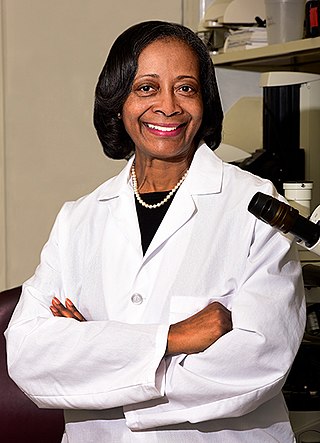Dilationand curettage (D&C) refers to the dilation of the cervix and surgical removal of part of the lining of the uterus or contents of the uterus by scraping and scooping (curettage). It is a gynecologic procedure used for diagnostic and therapeutic purposes, and is the most commonly used method for first-trimester miscarriage or abortion.

Epidemiology is the study and analysis of the distribution, patterns and determinants of health and disease conditions in a defined population.
Heavy menstrual bleeding (HMB), previously known as menorrhagia or hypermenorrhea, is a menstrual period with excessively heavy flow. It is a type of abnormal uterine bleeding (AUB).
Abnormal uterine bleeding (AUB), also known as (AVB) or as atypical vaginal bleeding, is vaginal bleeding from the uterus that is abnormally frequent, lasts excessively long, is heavier than normal, or is irregular. The term dysfunctional uterine bleeding was used when no underlying cause was present. Vaginal bleeding during pregnancy is excluded. Iron deficiency anemia may occur and quality of life may be negatively affected.

Vaginal bleeding is any expulsion of blood from the vagina. This bleeding may originate from the uterus, vaginal wall, or cervix. Generally, it is either part of a normal menstrual cycle or is caused by hormonal or other problems of the reproductive system, such as abnormal uterine bleeding.

Uterine fibroids, also known as uterine leiomyomas or fibroids, are benign smooth muscle tumors of the uterus. Most women with fibroids have no symptoms while others may have painful or heavy periods. If large enough, they may push on the bladder, causing a frequent need to urinate. They may also cause pain during penetrative sex or lower back pain. A woman can have one uterine fibroid or many. Occasionally, fibroids may make it difficult to become pregnant, although this is uncommon.

Myomectomy, sometimes also called fibroidectomy, refers to the surgical removal of uterine leiomyomas, also known as fibroids. In contrast to a hysterectomy, the uterus remains preserved and the woman retains her reproductive potential. It still may impact hormonal regulation and the menstrual cycle.
Dame Valerie Beral AC DBE FRS FRCOG FMedSci was an Australian-born British epidemiologist, academic and a preeminent specialist in breast cancer epidemiology. She was Professor of Epidemiology, a Fellow of Green Templeton College, Oxford and was the Head of the Cancer Epidemiology Unit at the University of Oxford and Cancer Research UK from 1989.
Genital leiomyomas are leiomyomas that originate in the dartos muscles, or smooth muscles, of the genitalia, areola, and nipple. They are a subtype of cutaneous leiomyomas that affect smooth muscle found in the scrotum, labia, or nipple. They are benign tumors, but may cause pain and discomfort to patients. Genital leiomyoma can be symptomatic or asymptomatic and is dependent on the type of leiomyoma. In most cases, pain in the affected area or region is most common. For vaginal leiomyoma, vaginal bleeding and pain may occur. Uterine leiomyoma may exhibit pain in the area as well as painful bowel movement and/or sexual intercourse. Nipple pain, enlargement, and tenderness can be a symptom of nipple-areolar leiomyomas. Genital leiomyomas can be caused by multiple factors, one can be genetic mutations that affect hormones such as estrogen and progesterone. Moreover, risk factors to the development of genital leiomyomas include age, race, and gender. Ultrasound and imaging procedures are used to diagnose genital leiomyomas, while surgically removing the tumor is the most common treatment of these diseases. Case studies for nipple areolar, scrotal, and uterine leiomyoma were used, since there were not enough secondary resources to provide more evidence.
Female genital disease is a disorder of the structure or function of the female reproductive system that has a known cause and a distinctive group of symptoms, signs, or anatomical changes. The female reproductive system consists of the ovaries, fallopian tubes, uterus, vagina, and vulva. Female genital diseases can be classified by affected location or by type of disease, such as malformation, inflammation, or infection.
David A. Savitz is a professor of Community Health in the Epidemiology Section of the Program in Public Health, Vice President for Research, and Professor of Obstetrics and Gynecology, at The Alpert Medical School of Brown University, and Associate Director for Perinatal Research in The Department of Obstetrics and Gynecology at Women & Infants Hospital, both in Providence, Rhode Island. Savitz is the author of Interpreting epidemiologic evidence: strategies for study design and analysis (ISBN 0-19-510840-X) and more than 275 peer-reviewed articles. He was elected to the Institute of Medicine in 2007.
Allen James Wilcox is an American epidemiologist who heads the reproductive epidemiology group at the National Institute of Environmental Health Sciences (NIEHS).

Lauren Anne Wise is a Canadian-American epidemiologist and Professor in the Department of Epidemiology at Boston University School of Public Health.

Louise Annette Brinton is an American epidemiologist. She was a senior investigator, Chief of the Hormonal and Reproductive Epidemiology Branch, and the first Scientific Advisor for International Activities of the National Cancer Institute Division of Cancer Epidemiology and Genetics.
Nina H. Fefferman is an American evolutionary biologist, epidemiologist, and ecologist at the University of Tennessee for the Departments of Ecology and Evolution & Mathematics. Her research focuses on the mathematics of epidemiology, evolutionary & behavioral ecology, and conservation biology. She studies how individual behaviors can affect an entire population.
Karin B. Michels is an epidemiologist currently serving as the Chair of the Department of Epidemiology for the Fielding School of Public Health at the University of California, Los Angeles.
Germaine M. Buck Louis is the Dean of the George Mason University College of Health and Human Services, a professor in Mason’s Department of Global and Community Health, and a reproductive and perinatal epidemiologist. Prior to her appointment as dean at George Mason in 2017, she was the founding Director for the Division of Intramural Population Health Research at the Eunice Kennedy Shriver National Institute of Child Health and Human Development.

Darlene Dixon is an American veterinary scientist and toxicologic pathologist researching the pathogenesis/carcinogenesis of tumors affecting the reproductive tract of rodents and humans and assessing the role of environmental and endogenous hormonal factors in the growth of these tumors. She is a senior investigator at the National Institute of Environmental Health Sciences.

Dale Pearlman Sandler is an American epidemiologist specialized in prospective cohort studies designed to study the impact of environmental exposures on population health. She is chief of the Epidemiology Branch at the National Institute of Environmental Health Sciences. Sandler is a past president of the American College of Epidemiology and received a Dr. Nathan Davis Award in 2015.
Donna Spiegelman is a biostatistician and epidemiologist who works at the interface between the two fields as a methodologist, applying statistical solutions to address potential biases in epidemiologic studies.








